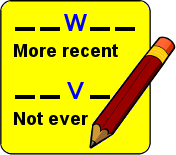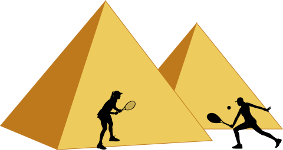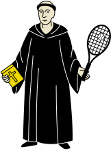Even Steven #41

How to play:
Even Steven puzzles are an excellent workout for crossword solvers. Each pair of lines below contains two clues and two 5- or 6-letter answers. The two answers are words which differ from each other by one letter, which has been provided in red. The remaining letters are ordered exactly the same in both answers. Your challenge is to guess the words from the two clues. For example, from the clues "Full of life" and "Exquisitely beautiful," you can arrive at the answers "LIVELY" and "LOVELY."
Printable Even Steven puzzles are also available.
Did you know?
Some historians believe the game of tennis is thousands of years old. The evidence is rather thin, but interesting. They point out how certain Arabic words, which date back to ancient Egyptian times, resemble words we use today to describe the game. For example, the Arabic word for the palm of the hand is rahat, which is similar to the English word racket. They also note how the word tennis may be derived from the Egyptian town of Tinnis.

More substantial evidence suggests that tennis only emerged around 1000 when French monks began playing a crude handball game against their monastery walls or over a rope stretched across a courtyard. The name they gave to their pastime was jeu de paume, meaning 'game of the palm.' According to this theory, the word tennis arose from the French tenez – meaning something to the effect of 'take this!' or 'play!' – which the Monks would shout as they served the ball to their opponent.

As the game grew in popularity, it spread outside the monastery walls to become adopted by the European nobility. The nobles took their new sport indoors. Some accounts claim there were as many as 1,800 indoor courts by 1200. At that time the game was still played off of walls with bare hands. But eventually gloves were constructed, either with webbing between the fingers or with an attached solid paddle. The ball they used was made from hair, wool, or cork wrapped in string, cloth, or leather. By 1500, a wooden frame racket strung with sheep gut was in common use, which players used to strike a cork-cored ball weighing about three ounces.

This Medieval form of 'real' or 'court' tennis – as it is now referred to – had very different rules to today's game. Games took place in narrow, indoor courts and the ball was played off angled walls which had a number of openings. Players scored points by hitting the ball over a drooping center net and into netted windows. During the 1700s, however, real tennis dwindled in popularity.

It's the American chemist Charles Goodyear who largely deserves credit for reviving and revolutioning the game of tennis. Goodyear had been working to improve tube tires and by the mid-1800s he made a breakthrough when he discovered the vulcanization process. This made for bouncier tennis balls and allowed the game to be played outside on grass courts. Since the new venue had no walls, tennis had to be quickly reinvented. And it was.

By the time the first Wimbledon tennis tournament was held in 1877, the game had court dimensions and a set of rules essentially as we know them today.

